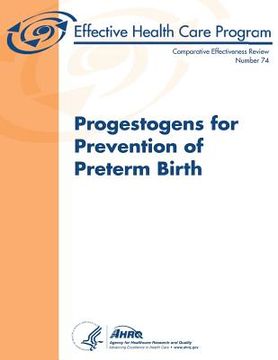Progestogens for Prevention of Preterm Birth: Comparative Effectiveness Review Number 74
Synopsis "Progestogens for Prevention of Preterm Birth: Comparative Effectiveness Review Number 74"
Birth before completion of 37 weeks of pregnancy is considered preterm. These early births are associated with more than 85 % of all perinatal morbidity and mortality and are the leading cause of infant mortality and long-term disability. Each year in the U.S. more than 475,000 infants are born preterm representing 12.5 % of live births. Efforts to reduce preterm birth have been largely unsuccessful, with a 20 % relative increase since 1990 in the proportion of births in the U.S. that are preterm. Morbidity and mortality associated with preterm birth represent untold distress for families, as well as significant costs to patients, health care systems, and payers. Average neonatal care costs are estimated to be $17,300 greater for preterm infants relative to term infants, amounting to more than $8.6 billion of annual medical spending in the U.S. The ultimate goal in preventing preterm birth is to eliminate the risks of neonatal complications and death and to ensure normal development. In the last decade, accumulating evidence from randomized clinical trials (RCTs) has led professional organizations and an Institute of Medicine working group to endorse the use of progestogens for women with prior spontaneous preterm birth. However, these groups also note interest in assessing long-term safety because the legacy of diethylstilbestrol suggests caution and extended followup of mothers and infants after hormone use in pregnancy. Unresolved issues about choice of progestogen, optimal route of drug delivery, and other candidate high-risk populations for treatment remain. To review the current state of the evidence we answered the following Key Questions. 1. In pregnant women who are at risk for preterm birth (which is birth before 37 weeks gestational age), does progestogen treatment, compared to a placebo, usual care, or other interventions improve maternal or fetal/neonatal health outcomes, including but not limited to: Complications during pregnancy (e.g., chorioamnionitis, antenatal hospitalizations and intrauterine growth restriction)? Mode of birth and complications during birth (e.g., cesarean birth and surgical complications)? Prematurity? Postpartum and neonatal complications (e.g., maternal postpartum hemorrhage and intraventricular hemorrhage)? Longer term outcomes (e.g., neurodevelopmental delay and future reproductive outcomes)? 2. What is the nature and frequency of maternal and child adverse effects of progestogen treatment, including but not limited to: Complications during pregnancy (e.g. allergic reactions or development of gestational diabetes)? Mode of birth and complications during birth (e.g., unanticipated maternal harms)? Postpartum and neonatal complications (e.g., infections and sepsis)? Longer term outcomes? 3. How do the effectiveness, adverse effects, and safety of progestogen treatment differ based on the maternal risk factors for preterm birth, such as severity of prior preterm birth, degree of cervical shortening, order of multiple gestations, fetal fibronectin status, preterm premature rupture of membranes (PPROM), threatened preterm birth, and socioeconomic predictors of prematurity, including race/ethnicity? 4. How do the effectiveness, acceptability, adherence, adverse effects, and safety of progestogen treatment differ, based on the formulation, dose, frequency of administration, and gestational age at initiation or discontinuation of progestogen therapy? 5. How do the effectiveness, adverse effects, and safety of progestogen treatment differ based on cointerventions used to prevent preterm birth and its consequences, including antibiotics, corticosteroids, tocolysis, and surgical interventions such as cervical cerclage? 6. What are the effects of health system and provider factors, including provider knowledge and attitudes, provider specialty, cost of drug, availability of drug in formularies, and Medicaid and private payer coverage, on the utilization of progestogens for eligible at risk women?

